University of Derby: Financial Strategy Analysis of Engie Company
VerifiedAdded on 2022/10/06
|12
|2516
|90
Report
AI Summary
This report provides a comprehensive financial strategy analysis of Engie Company. It examines the company's capital structure, including debt-to-equity and debt-to-total capital ratios, analyzing trends from 2016 to 2017. The report delves into the theoretical advantages and disadvantages of Engie's capital structure using various approaches such as Net Income, Net Operating Income, Traditional Theory, and Modigliani approaches. Furthermore, it assesses the company's short-term finance perspective, evaluating operating income margins and current ratios. The report also discusses the application of the matching principle and the importance of working capital management, offering insights into Engie's financial health and providing a foundation for understanding financial decision-making.

Running head: FINANCIAL STRATEGY
Financial Strategy
Name of the Student:
Name of the University:
Author’s Note:
Financial Strategy
Name of the Student:
Name of the University:
Author’s Note:
Paraphrase This Document
Need a fresh take? Get an instant paraphrase of this document with our AI Paraphraser
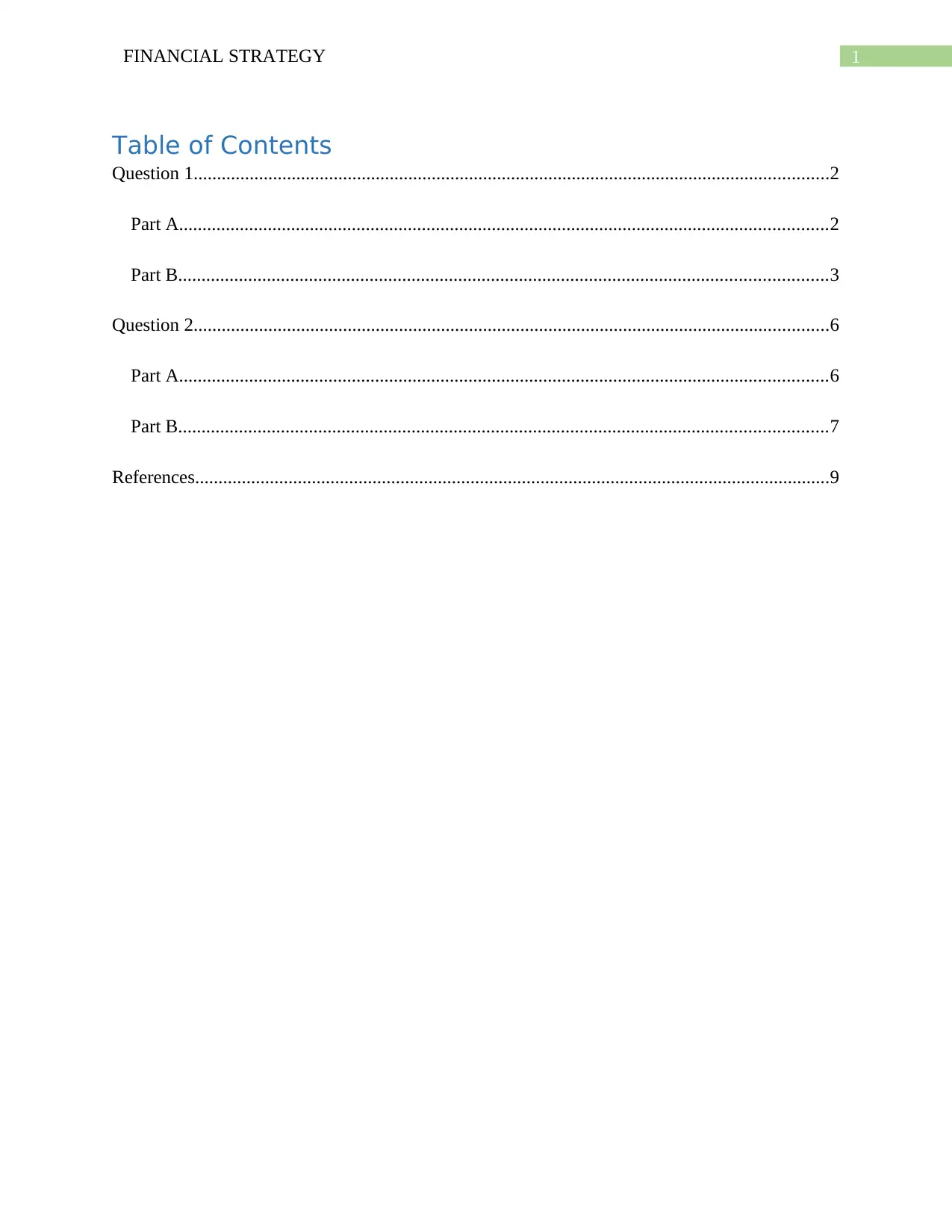
1FINANCIAL STRATEGY
Table of Contents
Question 1........................................................................................................................................2
Part A...........................................................................................................................................2
Part B...........................................................................................................................................3
Question 2........................................................................................................................................6
Part A...........................................................................................................................................6
Part B...........................................................................................................................................7
References........................................................................................................................................9
Table of Contents
Question 1........................................................................................................................................2
Part A...........................................................................................................................................2
Part B...........................................................................................................................................3
Question 2........................................................................................................................................6
Part A...........................................................................................................................................6
Part B...........................................................................................................................................7
References........................................................................................................................................9

2FINANCIAL STRATEGY
Question 1
Part A
Capital structure of a entity explains about the mix of various capital sources that the
company deploys for the purpose of optimizing the capital structure. A capital structure of a
company usually contains long term sources of finance like equity, debt and preference shares.
The capital structure of Engie’s can be well analysed with the help of debt and equity balance
reflected in the financial statement of the company (Sundaresan, Wang and Yang 2015). It is
hence forth very important for the companies to maintain a capital structure that is optimum and
hence forth requires the company to maintain an optimal capital in the financials of the company.
The capital sources used and deployed by the company in the financials of the company should
be at a ratio such that the financial and business risk of the company stays at an optimal rate. The
key aspects that have been deployed for the purpose of calculating the capital structure that are
primarily in the form of debt to equity ratio and debt/equity to total capital ratio for a firm
(Faccio and Xu 2015).
Debt to Equity Ratio: The stated/calculated debt to equity ratio for Engie’s Company has been
around 53.68% in the year 2016 and the same has increased considerably for the company to
around 59.40% in the year 2017. The key reason for the increase was due to the increase in the
long-term debt of the company whereby company has used more of debt financing for the
purpose of financing the various operations of the company (Allen, Carletti and Marquez 2015).
It is important to note that on the other hand, it is important to note that debt financing is
comparatively cheaper for the companies that allows companies to raise more of low cost
financing reducing the overall cost of capital. Debt financing on the one hand, also allows the
Question 1
Part A
Capital structure of a entity explains about the mix of various capital sources that the
company deploys for the purpose of optimizing the capital structure. A capital structure of a
company usually contains long term sources of finance like equity, debt and preference shares.
The capital structure of Engie’s can be well analysed with the help of debt and equity balance
reflected in the financial statement of the company (Sundaresan, Wang and Yang 2015). It is
hence forth very important for the companies to maintain a capital structure that is optimum and
hence forth requires the company to maintain an optimal capital in the financials of the company.
The capital sources used and deployed by the company in the financials of the company should
be at a ratio such that the financial and business risk of the company stays at an optimal rate. The
key aspects that have been deployed for the purpose of calculating the capital structure that are
primarily in the form of debt to equity ratio and debt/equity to total capital ratio for a firm
(Faccio and Xu 2015).
Debt to Equity Ratio: The stated/calculated debt to equity ratio for Engie’s Company has been
around 53.68% in the year 2016 and the same has increased considerably for the company to
around 59.40% in the year 2017. The key reason for the increase was due to the increase in the
long-term debt of the company whereby company has used more of debt financing for the
purpose of financing the various operations of the company (Allen, Carletti and Marquez 2015).
It is important to note that on the other hand, it is important to note that debt financing is
comparatively cheaper for the companies that allows companies to raise more of low cost
financing reducing the overall cost of capital. Debt financing on the one hand, also allows the
⊘ This is a preview!⊘
Do you want full access?
Subscribe today to unlock all pages.

Trusted by 1+ million students worldwide
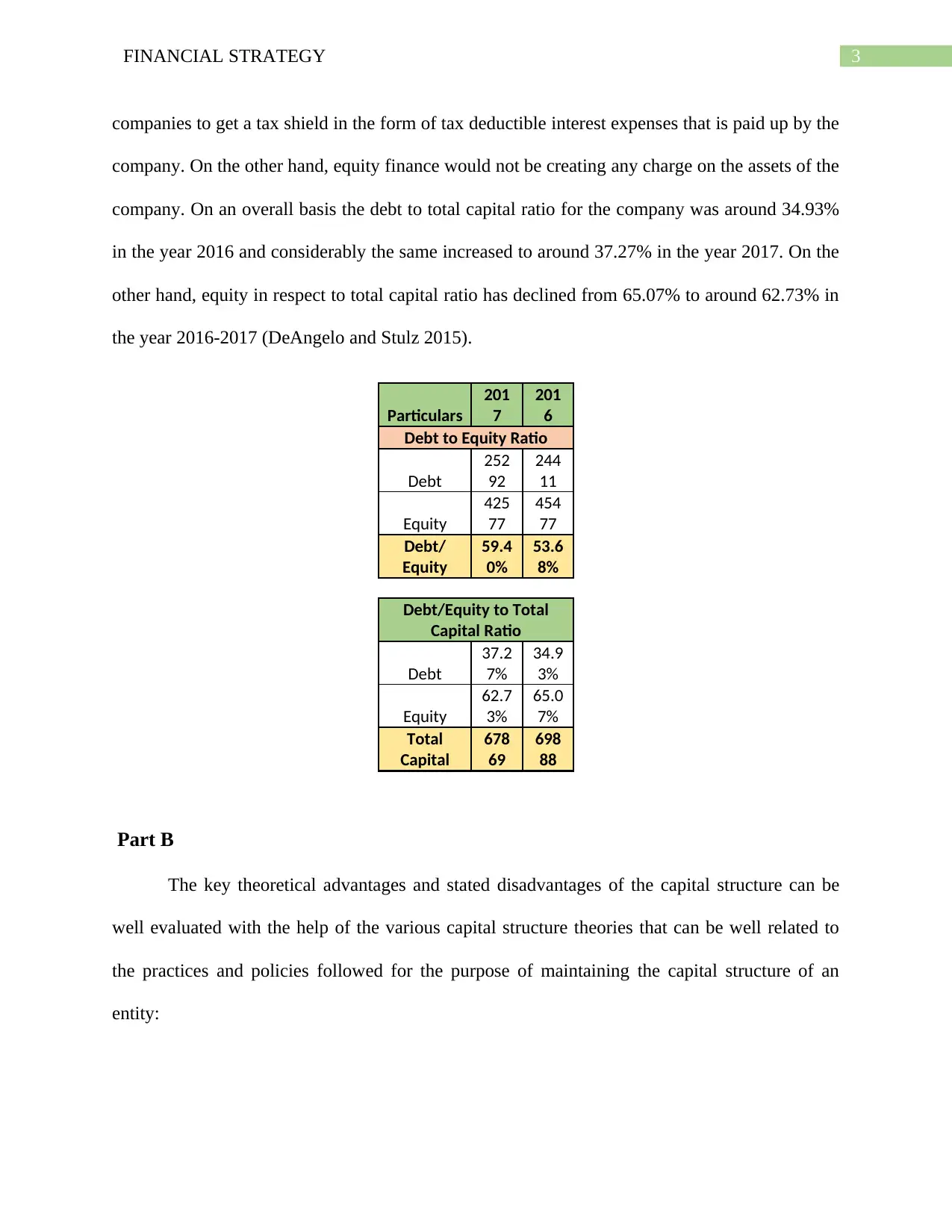
3FINANCIAL STRATEGY
companies to get a tax shield in the form of tax deductible interest expenses that is paid up by the
company. On the other hand, equity finance would not be creating any charge on the assets of the
company. On an overall basis the debt to total capital ratio for the company was around 34.93%
in the year 2016 and considerably the same increased to around 37.27% in the year 2017. On the
other hand, equity in respect to total capital ratio has declined from 65.07% to around 62.73% in
the year 2016-2017 (DeAngelo and Stulz 2015).
Particulars
201
7
201
6
Debt to Equity Ratio
Debt
252
92
244
11
Equity
425
77
454
77
Debt/
Equity
59.4
0%
53.6
8%
Debt/Equity to Total
Capital Ratio
Debt
37.2
7%
34.9
3%
Equity
62.7
3%
65.0
7%
Total
Capital
678
69
698
88
Part B
The key theoretical advantages and stated disadvantages of the capital structure can be
well evaluated with the help of the various capital structure theories that can be well related to
the practices and policies followed for the purpose of maintaining the capital structure of an
entity:
companies to get a tax shield in the form of tax deductible interest expenses that is paid up by the
company. On the other hand, equity finance would not be creating any charge on the assets of the
company. On an overall basis the debt to total capital ratio for the company was around 34.93%
in the year 2016 and considerably the same increased to around 37.27% in the year 2017. On the
other hand, equity in respect to total capital ratio has declined from 65.07% to around 62.73% in
the year 2016-2017 (DeAngelo and Stulz 2015).
Particulars
201
7
201
6
Debt to Equity Ratio
Debt
252
92
244
11
Equity
425
77
454
77
Debt/
Equity
59.4
0%
53.6
8%
Debt/Equity to Total
Capital Ratio
Debt
37.2
7%
34.9
3%
Equity
62.7
3%
65.0
7%
Total
Capital
678
69
698
88
Part B
The key theoretical advantages and stated disadvantages of the capital structure can be
well evaluated with the help of the various capital structure theories that can be well related to
the practices and policies followed for the purpose of maintaining the capital structure of an
entity:
Paraphrase This Document
Need a fresh take? Get an instant paraphrase of this document with our AI Paraphraser

4FINANCIAL STRATEGY
Net Income Approach: Engie’s can increase the overall value of the firm with the help of
lowering the cost associated with the capital of the company. If the cost of capital would be
lower for the company then the same would be allowing the company report a greater value
associated with the same and we call it optimisation of the capital structure so that the share price
associated with the company as a result of increasing firm’s value. The same can be well related
in the case of Engie Company where the cost of capital may have fallen for the company with the
increase in debt financing but the same is costing the company with increased financial exposure
towards debt financing.
Net Operating Income Approach: The NOI Approach for the company states about the various
usage of the firm’s capital sources and the overall capitalisation rate that has been applied by the
company which is constant for all degree of leverages. Under this approach the cost of debt will
be remaining constant and the cost of equity would be rising making the total cost of capital to be
stable for the company. It is important to note that for the Engie Company the cost of debt may
not remain cost as equity finance increases or as when the firms take on more and more amount
of debt financing that ultimately would increase the financial exposure.
Net Income Approach: Engie’s can increase the overall value of the firm with the help of
lowering the cost associated with the capital of the company. If the cost of capital would be
lower for the company then the same would be allowing the company report a greater value
associated with the same and we call it optimisation of the capital structure so that the share price
associated with the company as a result of increasing firm’s value. The same can be well related
in the case of Engie Company where the cost of capital may have fallen for the company with the
increase in debt financing but the same is costing the company with increased financial exposure
towards debt financing.
Net Operating Income Approach: The NOI Approach for the company states about the various
usage of the firm’s capital sources and the overall capitalisation rate that has been applied by the
company which is constant for all degree of leverages. Under this approach the cost of debt will
be remaining constant and the cost of equity would be rising making the total cost of capital to be
stable for the company. It is important to note that for the Engie Company the cost of debt may
not remain cost as equity finance increases or as when the firms take on more and more amount
of debt financing that ultimately would increase the financial exposure.
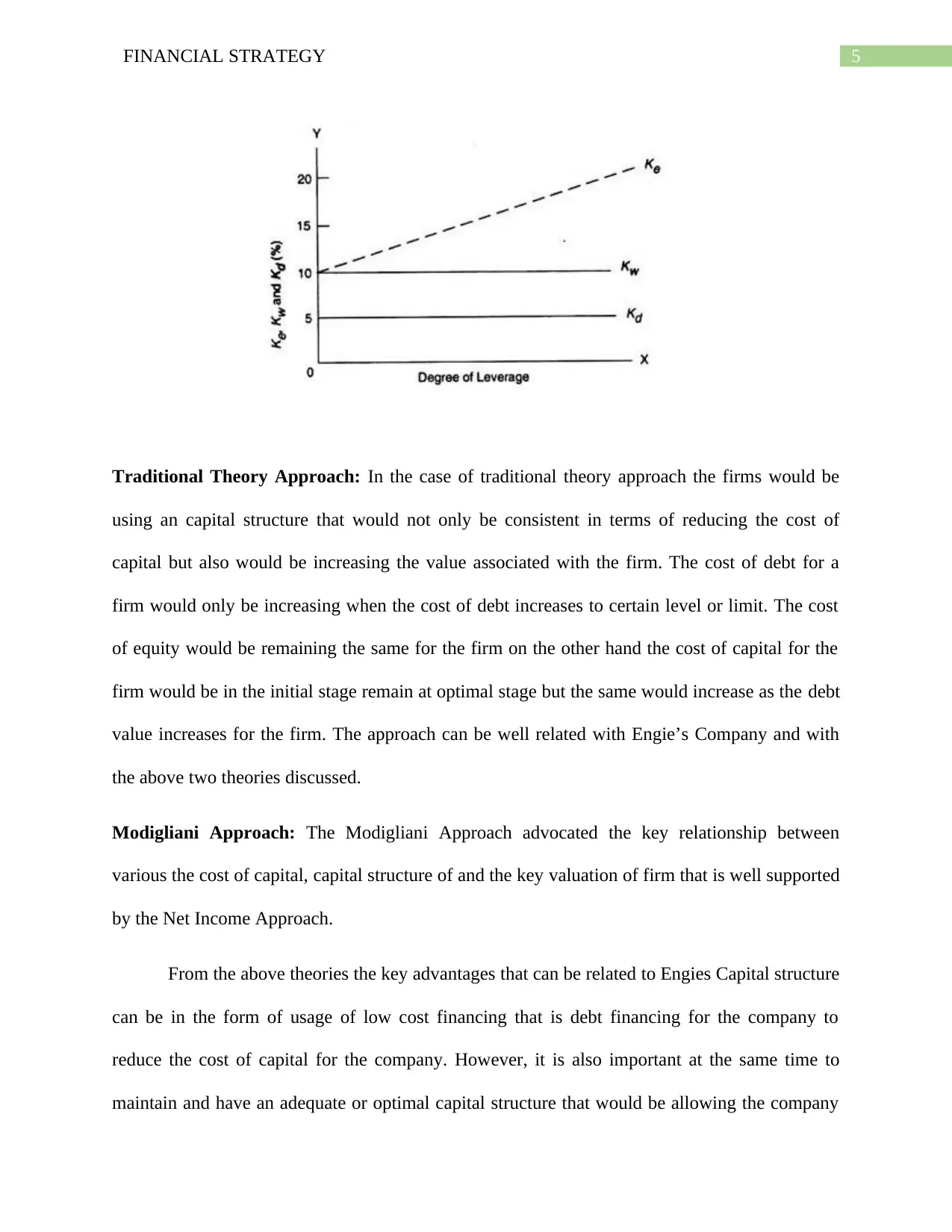
5FINANCIAL STRATEGY
Traditional Theory Approach: In the case of traditional theory approach the firms would be
using an capital structure that would not only be consistent in terms of reducing the cost of
capital but also would be increasing the value associated with the firm. The cost of debt for a
firm would only be increasing when the cost of debt increases to certain level or limit. The cost
of equity would be remaining the same for the firm on the other hand the cost of capital for the
firm would be in the initial stage remain at optimal stage but the same would increase as the debt
value increases for the firm. The approach can be well related with Engie’s Company and with
the above two theories discussed.
Modigliani Approach: The Modigliani Approach advocated the key relationship between
various the cost of capital, capital structure of and the key valuation of firm that is well supported
by the Net Income Approach.
From the above theories the key advantages that can be related to Engies Capital structure
can be in the form of usage of low cost financing that is debt financing for the company to
reduce the cost of capital for the company. However, it is also important at the same time to
maintain and have an adequate or optimal capital structure that would be allowing the company
Traditional Theory Approach: In the case of traditional theory approach the firms would be
using an capital structure that would not only be consistent in terms of reducing the cost of
capital but also would be increasing the value associated with the firm. The cost of debt for a
firm would only be increasing when the cost of debt increases to certain level or limit. The cost
of equity would be remaining the same for the firm on the other hand the cost of capital for the
firm would be in the initial stage remain at optimal stage but the same would increase as the debt
value increases for the firm. The approach can be well related with Engie’s Company and with
the above two theories discussed.
Modigliani Approach: The Modigliani Approach advocated the key relationship between
various the cost of capital, capital structure of and the key valuation of firm that is well supported
by the Net Income Approach.
From the above theories the key advantages that can be related to Engies Capital structure
can be in the form of usage of low cost financing that is debt financing for the company to
reduce the cost of capital for the company. However, it is also important at the same time to
maintain and have an adequate or optimal capital structure that would be allowing the company
⊘ This is a preview!⊘
Do you want full access?
Subscribe today to unlock all pages.

Trusted by 1+ million students worldwide
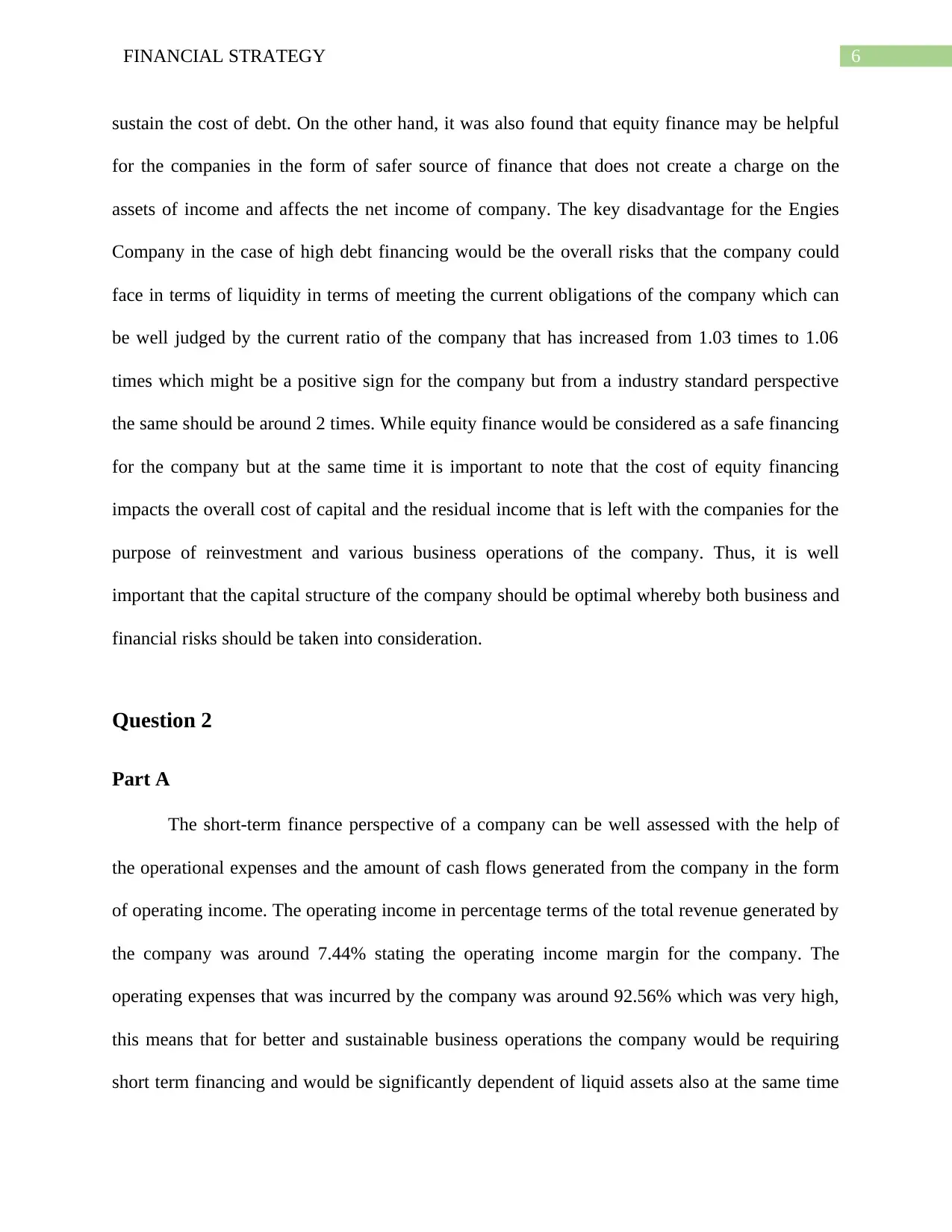
6FINANCIAL STRATEGY
sustain the cost of debt. On the other hand, it was also found that equity finance may be helpful
for the companies in the form of safer source of finance that does not create a charge on the
assets of income and affects the net income of company. The key disadvantage for the Engies
Company in the case of high debt financing would be the overall risks that the company could
face in terms of liquidity in terms of meeting the current obligations of the company which can
be well judged by the current ratio of the company that has increased from 1.03 times to 1.06
times which might be a positive sign for the company but from a industry standard perspective
the same should be around 2 times. While equity finance would be considered as a safe financing
for the company but at the same time it is important to note that the cost of equity financing
impacts the overall cost of capital and the residual income that is left with the companies for the
purpose of reinvestment and various business operations of the company. Thus, it is well
important that the capital structure of the company should be optimal whereby both business and
financial risks should be taken into consideration.
Question 2
Part A
The short-term finance perspective of a company can be well assessed with the help of
the operational expenses and the amount of cash flows generated from the company in the form
of operating income. The operating income in percentage terms of the total revenue generated by
the company was around 7.44% stating the operating income margin for the company. The
operating expenses that was incurred by the company was around 92.56% which was very high,
this means that for better and sustainable business operations the company would be requiring
short term financing and would be significantly dependent of liquid assets also at the same time
sustain the cost of debt. On the other hand, it was also found that equity finance may be helpful
for the companies in the form of safer source of finance that does not create a charge on the
assets of income and affects the net income of company. The key disadvantage for the Engies
Company in the case of high debt financing would be the overall risks that the company could
face in terms of liquidity in terms of meeting the current obligations of the company which can
be well judged by the current ratio of the company that has increased from 1.03 times to 1.06
times which might be a positive sign for the company but from a industry standard perspective
the same should be around 2 times. While equity finance would be considered as a safe financing
for the company but at the same time it is important to note that the cost of equity financing
impacts the overall cost of capital and the residual income that is left with the companies for the
purpose of reinvestment and various business operations of the company. Thus, it is well
important that the capital structure of the company should be optimal whereby both business and
financial risks should be taken into consideration.
Question 2
Part A
The short-term finance perspective of a company can be well assessed with the help of
the operational expenses and the amount of cash flows generated from the company in the form
of operating income. The operating income in percentage terms of the total revenue generated by
the company was around 7.44% stating the operating income margin for the company. The
operating expenses that was incurred by the company was around 92.56% which was very high,
this means that for better and sustainable business operations the company would be requiring
short term financing and would be significantly dependent of liquid assets also at the same time
Paraphrase This Document
Need a fresh take? Get an instant paraphrase of this document with our AI Paraphraser

7FINANCIAL STRATEGY
for the purpose of financing the business operations (Serfling 2016). The short-term finance
requirement for the company can be well assessed with the help of current ratio stating the
current obligations that the company might be able to meet or not. The current ratio for the
company was around 1.03 times in the year 2016 and the same has increased marginally to
around 1.06 times in the year 2017 (Klasa et al., 2018). The increase in the current ratio for the
company has been predominantly due to the decrease in the current liabilities of the company. At
the same time it is crucial to note that the financial requirements for the company can be well
judged with the above stated numbers which is particularly not matching up with the industry
standards. The company should take appropriate set of measures for the purpose of increasing
the overall liquidity position of the company by increasing the short-term assets so that the
financial requirement can be well met and the business operations can be well carried on
(Schepens 2016).
Current Ratio
Current Assets
5816
1
5959
5
Current
Liabilities
5479
5
5759
1
Current Ratio 1.06 1.03
Matching principle serves as one of the basic accounting principles that is underlying in
the accounting process, whereby the principle directs the company in reporting the various
expenses that are incurred by the company as a part of expenses in the income statement under
which the related revenues are generally earned by the company (Graham et al., 2015). The key
purpose of applying the matching principle in the revenue recognition principles is applied so
that the company can further avoid any kind of misstatement of earnings for the reported period.
The key principles that can simply explain the matching concept principle is the cause and effect
for the purpose of financing the business operations (Serfling 2016). The short-term finance
requirement for the company can be well assessed with the help of current ratio stating the
current obligations that the company might be able to meet or not. The current ratio for the
company was around 1.03 times in the year 2016 and the same has increased marginally to
around 1.06 times in the year 2017 (Klasa et al., 2018). The increase in the current ratio for the
company has been predominantly due to the decrease in the current liabilities of the company. At
the same time it is crucial to note that the financial requirements for the company can be well
judged with the above stated numbers which is particularly not matching up with the industry
standards. The company should take appropriate set of measures for the purpose of increasing
the overall liquidity position of the company by increasing the short-term assets so that the
financial requirement can be well met and the business operations can be well carried on
(Schepens 2016).
Current Ratio
Current Assets
5816
1
5959
5
Current
Liabilities
5479
5
5759
1
Current Ratio 1.06 1.03
Matching principle serves as one of the basic accounting principles that is underlying in
the accounting process, whereby the principle directs the company in reporting the various
expenses that are incurred by the company as a part of expenses in the income statement under
which the related revenues are generally earned by the company (Graham et al., 2015). The key
purpose of applying the matching principle in the revenue recognition principles is applied so
that the company can further avoid any kind of misstatement of earnings for the reported period.
The key principles that can simply explain the matching concept principle is the cause and effect

8FINANCIAL STRATEGY
relationship between the revenue and certain expenses of the company. Thus, on an conclusive
note it can be well stated that the accounting concept can help the investors and at the same time
the management of the company in the preparation of the financial reports of the company, If the
accounting concepts and principles are well used for the purpose of presentation of the financial
statement then the same would be allowing the investors better assess the financial position of
the company.
Part B
Working Capital plays an important role in the financial structure of the company and the
same can be well explained with the help of the analysis that was done for Engie’s Company that
states that the working capital for the company was around £2,004 million in the year 2017 and
the same has increased to around £3,366 million in the year 2017 (Mathuva 2015). It is very
important that the company maintains an adequate amount of working capital so that the business
operations of the company are well carried on and the company does not face any liquidity crisis
that would ultimately affecting the business operations of the company (Aktas, Croci and
Petmezas 2015). If Engie’s does not maintain an sufficient amount of working capital than the
same would be costing the company in the form of higher costs of financing that the company
would have to borrow so that the business operations of the company runs smoothly and
effectively. There are several steps and actions that the management of the company for the
purpose of forecasting the various expenses and income sources that the company will be
incurring in the trend period and take decisions accordingly so that on an overall basis the
working capital requirement can be better assessed by the investors (Pais and Gama 2015). On a
conclusive note it can be well said that the working capital plays an important role and
companies should take several measures for the purpose of maintaining an subsequent amount of
relationship between the revenue and certain expenses of the company. Thus, on an conclusive
note it can be well stated that the accounting concept can help the investors and at the same time
the management of the company in the preparation of the financial reports of the company, If the
accounting concepts and principles are well used for the purpose of presentation of the financial
statement then the same would be allowing the investors better assess the financial position of
the company.
Part B
Working Capital plays an important role in the financial structure of the company and the
same can be well explained with the help of the analysis that was done for Engie’s Company that
states that the working capital for the company was around £2,004 million in the year 2017 and
the same has increased to around £3,366 million in the year 2017 (Mathuva 2015). It is very
important that the company maintains an adequate amount of working capital so that the business
operations of the company are well carried on and the company does not face any liquidity crisis
that would ultimately affecting the business operations of the company (Aktas, Croci and
Petmezas 2015). If Engie’s does not maintain an sufficient amount of working capital than the
same would be costing the company in the form of higher costs of financing that the company
would have to borrow so that the business operations of the company runs smoothly and
effectively. There are several steps and actions that the management of the company for the
purpose of forecasting the various expenses and income sources that the company will be
incurring in the trend period and take decisions accordingly so that on an overall basis the
working capital requirement can be better assessed by the investors (Pais and Gama 2015). On a
conclusive note it can be well said that the working capital plays an important role and
companies should take several measures for the purpose of maintaining an subsequent amount of
⊘ This is a preview!⊘
Do you want full access?
Subscribe today to unlock all pages.

Trusted by 1+ million students worldwide

9FINANCIAL STRATEGY
working capital in the company. The key advantage that Engies would be facing with the help of
maintain an optimal capital structure would be in the field of better financial management of
resources. On the other hand, the key disadvantages of not having an sufficient amount of
working capital would be in the form of business costs and fail in business process of the
companies impacting the overall revenue and costs associated with the company (Faccio and Xu
2015).
working capital in the company. The key advantage that Engies would be facing with the help of
maintain an optimal capital structure would be in the field of better financial management of
resources. On the other hand, the key disadvantages of not having an sufficient amount of
working capital would be in the form of business costs and fail in business process of the
companies impacting the overall revenue and costs associated with the company (Faccio and Xu
2015).
Paraphrase This Document
Need a fresh take? Get an instant paraphrase of this document with our AI Paraphraser
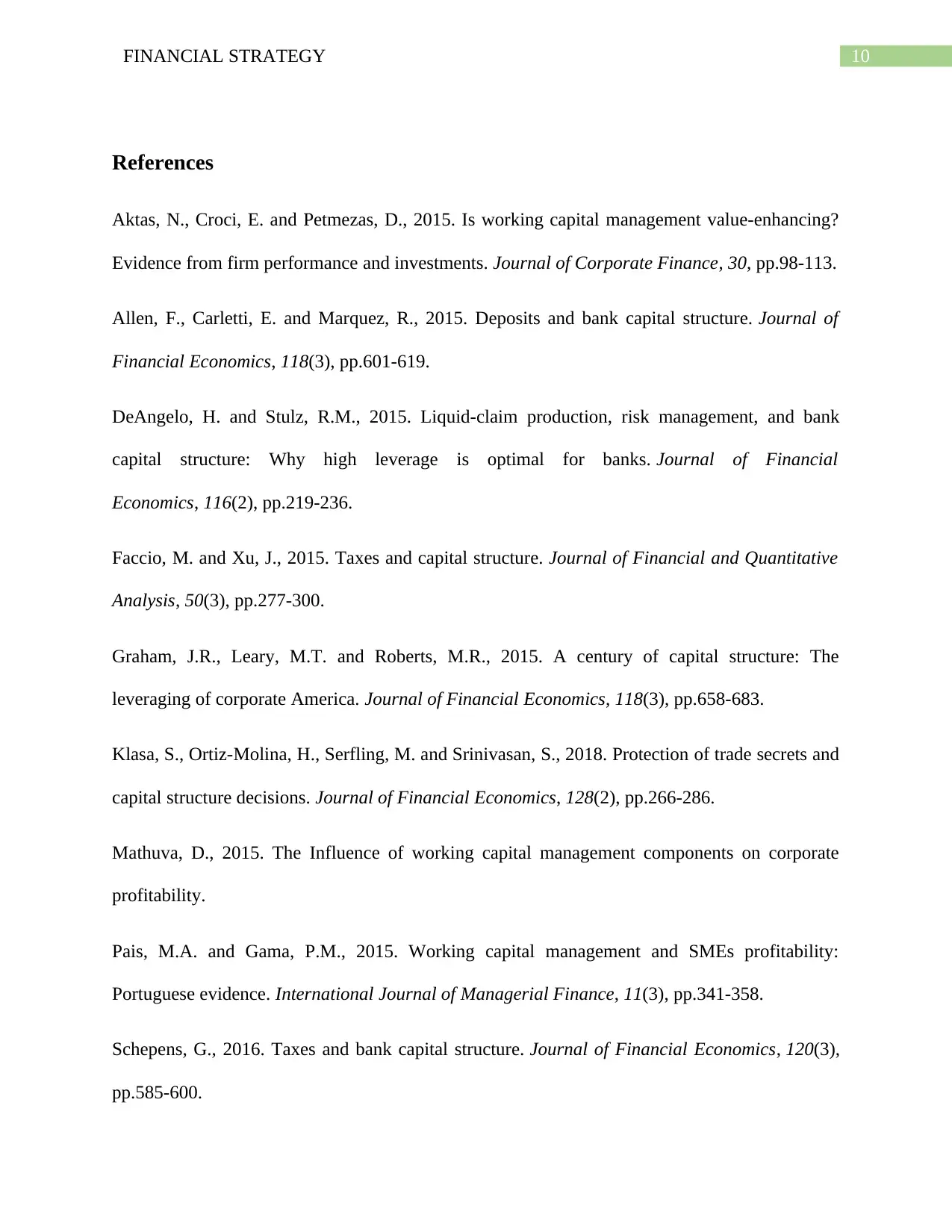
10FINANCIAL STRATEGY
References
Aktas, N., Croci, E. and Petmezas, D., 2015. Is working capital management value-enhancing?
Evidence from firm performance and investments. Journal of Corporate Finance, 30, pp.98-113.
Allen, F., Carletti, E. and Marquez, R., 2015. Deposits and bank capital structure. Journal of
Financial Economics, 118(3), pp.601-619.
DeAngelo, H. and Stulz, R.M., 2015. Liquid-claim production, risk management, and bank
capital structure: Why high leverage is optimal for banks. Journal of Financial
Economics, 116(2), pp.219-236.
Faccio, M. and Xu, J., 2015. Taxes and capital structure. Journal of Financial and Quantitative
Analysis, 50(3), pp.277-300.
Graham, J.R., Leary, M.T. and Roberts, M.R., 2015. A century of capital structure: The
leveraging of corporate America. Journal of Financial Economics, 118(3), pp.658-683.
Klasa, S., Ortiz-Molina, H., Serfling, M. and Srinivasan, S., 2018. Protection of trade secrets and
capital structure decisions. Journal of Financial Economics, 128(2), pp.266-286.
Mathuva, D., 2015. The Influence of working capital management components on corporate
profitability.
Pais, M.A. and Gama, P.M., 2015. Working capital management and SMEs profitability:
Portuguese evidence. International Journal of Managerial Finance, 11(3), pp.341-358.
Schepens, G., 2016. Taxes and bank capital structure. Journal of Financial Economics, 120(3),
pp.585-600.
References
Aktas, N., Croci, E. and Petmezas, D., 2015. Is working capital management value-enhancing?
Evidence from firm performance and investments. Journal of Corporate Finance, 30, pp.98-113.
Allen, F., Carletti, E. and Marquez, R., 2015. Deposits and bank capital structure. Journal of
Financial Economics, 118(3), pp.601-619.
DeAngelo, H. and Stulz, R.M., 2015. Liquid-claim production, risk management, and bank
capital structure: Why high leverage is optimal for banks. Journal of Financial
Economics, 116(2), pp.219-236.
Faccio, M. and Xu, J., 2015. Taxes and capital structure. Journal of Financial and Quantitative
Analysis, 50(3), pp.277-300.
Graham, J.R., Leary, M.T. and Roberts, M.R., 2015. A century of capital structure: The
leveraging of corporate America. Journal of Financial Economics, 118(3), pp.658-683.
Klasa, S., Ortiz-Molina, H., Serfling, M. and Srinivasan, S., 2018. Protection of trade secrets and
capital structure decisions. Journal of Financial Economics, 128(2), pp.266-286.
Mathuva, D., 2015. The Influence of working capital management components on corporate
profitability.
Pais, M.A. and Gama, P.M., 2015. Working capital management and SMEs profitability:
Portuguese evidence. International Journal of Managerial Finance, 11(3), pp.341-358.
Schepens, G., 2016. Taxes and bank capital structure. Journal of Financial Economics, 120(3),
pp.585-600.
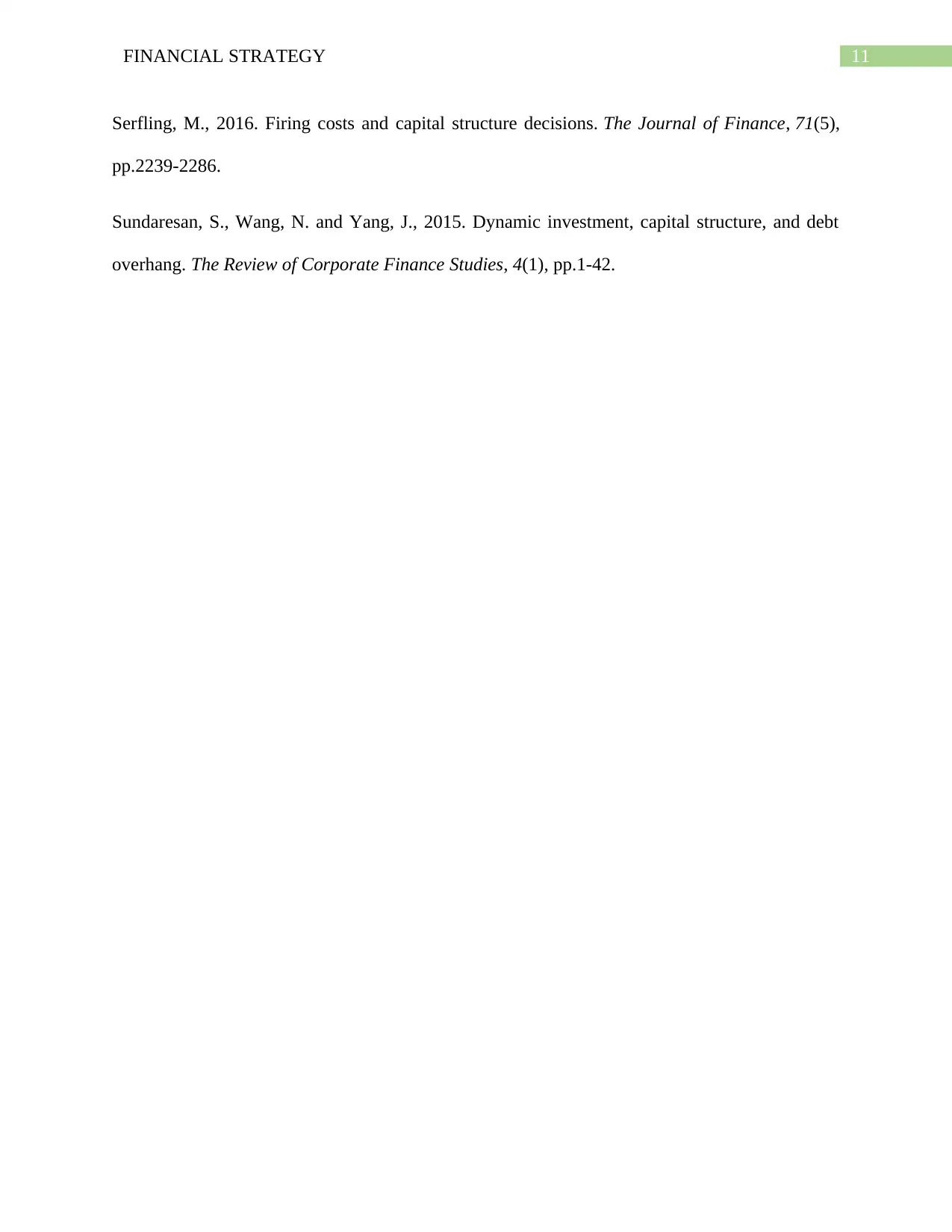
11FINANCIAL STRATEGY
Serfling, M., 2016. Firing costs and capital structure decisions. The Journal of Finance, 71(5),
pp.2239-2286.
Sundaresan, S., Wang, N. and Yang, J., 2015. Dynamic investment, capital structure, and debt
overhang. The Review of Corporate Finance Studies, 4(1), pp.1-42.
Serfling, M., 2016. Firing costs and capital structure decisions. The Journal of Finance, 71(5),
pp.2239-2286.
Sundaresan, S., Wang, N. and Yang, J., 2015. Dynamic investment, capital structure, and debt
overhang. The Review of Corporate Finance Studies, 4(1), pp.1-42.
⊘ This is a preview!⊘
Do you want full access?
Subscribe today to unlock all pages.

Trusted by 1+ million students worldwide
1 out of 12
Related Documents
Your All-in-One AI-Powered Toolkit for Academic Success.
+13062052269
info@desklib.com
Available 24*7 on WhatsApp / Email
![[object Object]](/_next/static/media/star-bottom.7253800d.svg)
Unlock your academic potential
Copyright © 2020–2025 A2Z Services. All Rights Reserved. Developed and managed by ZUCOL.





